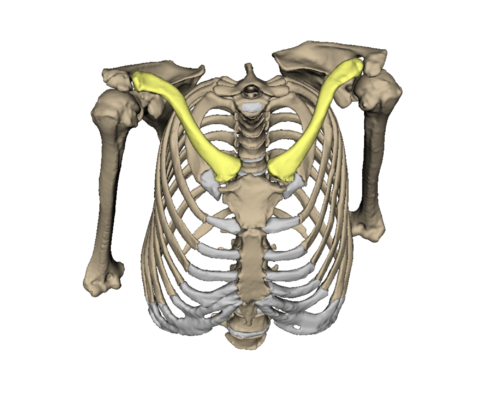Schultergürtel/en: Unterschied zwischen den Versionen
(Die Seite wurde neu angelegt: „The shoulder girdle provides stability between the trunk and the upper free limb. This is ensured less by bony connections than much more by the Special:MyLa…“) |
(Die Seite wurde neu angelegt: „==Movement==“) |
||
| Zeile 50: | Zeile 50: | ||
The shoulder girdle provides stability between the trunk and the upper free limb. This is ensured less by bony connections than much more by the [[Special:MyLanguage/Schultergürtelmuskulatur|shoulder girdle musculature]]. This also ensures good movement of the shoulder. The clavicle and the scapula have only little movement to each other. However, the combination with the musculature and the [[Special:MyLanguage/Humeroskapulargelenk|shoulder joint]] allows a very large range of motion. | The shoulder girdle provides stability between the trunk and the upper free limb. This is ensured less by bony connections than much more by the [[Special:MyLanguage/Schultergürtelmuskulatur|shoulder girdle musculature]]. This also ensures good movement of the shoulder. The clavicle and the scapula have only little movement to each other. However, the combination with the musculature and the [[Special:MyLanguage/Humeroskapulargelenk|shoulder joint]] allows a very large range of motion. | ||
| − | == | + | ==Movement== |
Die Scapula und die Clavicula sind durch die Schlüsselbeingelenke mechanisch miteinander verbunden. Dadurch bewegt sich das Schulterblatt bei jeder Bewegung des Schlüsselbeines mit. Die Scapula gleitet dann über den Thorax bedingt durch das Schulterblatt-Thorax-Gelenk. die Scapula kann folgende Bewegungen vollziehen: | Die Scapula und die Clavicula sind durch die Schlüsselbeingelenke mechanisch miteinander verbunden. Dadurch bewegt sich das Schulterblatt bei jeder Bewegung des Schlüsselbeines mit. Die Scapula gleitet dann über den Thorax bedingt durch das Schulterblatt-Thorax-Gelenk. die Scapula kann folgende Bewegungen vollziehen: | ||
Version vom 6. Februar 2020, 08:06 Uhr
Shoulder blade (Scapula)
Collarbone (Clavicula)
Acromioclavicular joint
Sternoclavicular joint
Humeroscapular joint
Shoulder girdle musculature
Inhaltsverzeichnis
Overview
The shoulder girdle connects the free upper extremity with the Trunk. The bony structure consists of the Scapula (Shoulder blade) and the Clavicula (collarbone). The two bones are connected by the acromioclavicular joint (Art. acromioclavicularis). The collarbone has a direct connection to the trunk via the sternoclavicular joint (Art. sternoclavicularis). The shoulder blade, on the other hand, is embedded in muscle loops and has no direct connection to the trunk.
Anatomy
The shoulder girdle has a bony structure in pairs and consists of the scapula (shoulder blade) and clavicle (collarbone) on both the right and left sides of the body. The clavicle is an "s"-shaped curved tubular Bone. The shoulder blade, on the other hand, is formed by a flat triangular bone embedded in muscle loops. The free upper extremities (arms) are connected to the trunk by the shoulder girdle. The direct connection is through the sternoclavicular joint, also called medial clavicle joint. This is the point where the clavicle and sternum meet and is the only bony connection between the upper extremities and the trunk. The scapula and clavicle correlate with each other via the acromioclavicular joint (lateral clavicle joint). The humeroscapular joint (shoulder joint) connects the Humerus with the shoulder girdle.
Alignment of clavicle and scapula
As a result of the evolutionary uprighting of the human being to an upright position, the shoulder blades have shifted dorsally to the almost frontal rear surface of the thorax. In a cranial view, the scapula and the frontal plane form an angle of 30°. Between the clavicle and the scapula is a larger angle of about 60°. This causes the shoulder joints to tilt forward slightly.
Shoulder girdle as a zonoskeleton
The shoulder girdle, like the pelvic girdle, belongs to the zonoskeleton. These are bone elements that are attached proximally to the trunk. Here this is fulfilled by the shoulder blade and the collarbone. The shoulder girdle thus represents a movable body appendage, which is formed by different sections.
Function
The shoulder girdle provides stability between the trunk and the upper free limb. This is ensured less by bony connections than much more by the shoulder girdle musculature. This also ensures good movement of the shoulder. The clavicle and the scapula have only little movement to each other. However, the combination with the musculature and the shoulder joint allows a very large range of motion.
Movement
Die Scapula und die Clavicula sind durch die Schlüsselbeingelenke mechanisch miteinander verbunden. Dadurch bewegt sich das Schulterblatt bei jeder Bewegung des Schlüsselbeines mit. Die Scapula gleitet dann über den Thorax bedingt durch das Schulterblatt-Thorax-Gelenk. die Scapula kann folgende Bewegungen vollziehen:
- Schwenken nach lateral
- Heben und Senken
- Vor- und Rückführen
Das Sternoklavikulargelenk sorgt für das Heben und Senken des Schulter um eine fast sagittale Achse. Das Vor und Rückführen um eine longitudinale Achse wird auch durch das mediale Schlüsselbeingelenk bedingt. Aus lateraler Sicht bewegt sich die Clavicula im Steroklavikulargelenk in etwa auf einem Kegelmantel.
Erkrankungen
weiterführende Links
